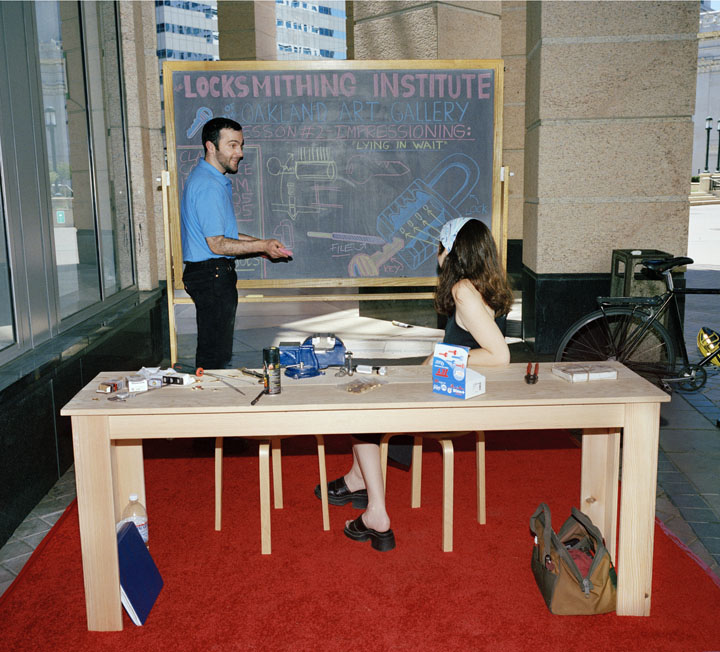The Locksmithing Institute of the Oakland Art Gallery, Oakland, CA, July, 2005
On two consecutive Saturdays I taught a class focusing on a method of key origination called “impressioning” in the city hall plaza of Oakland. Special thanks to Chris Woodcock for taking the photographs. Full lesson plan below:
The Locksmithing Institute of the Oakland Art Gallery
Lesson #2: Impressioning
Impressioning is probably one of the most useful and oldest skills that a locksmith has. It is a way of making a key to lock when the keys have been lost. To do this a locksmith takes an “uncut key” (a blank key that will fit into a lock but has no cuts on it) and rocks it back and forth in the lock. Then, looking for marks where the mechanisms hidden inside the lock have bound and rubbed against the blank key, the person slowly begins to file away the material from the uncut (blank) key. This process continues (sticking the blank key in, rocking it back and forth, examining, and then filing) until the lock turns.
The most difficult part of impressioning is deciding which of the many marks that one sees on the blank should be filed and which should be ignored. Because of this impressioning becomes the slow process of making decisions based on small bits of information that can not be measured but only inferred. When faced with a preponderance of information it is easy to make a decision. When one is faced with insufficient evidence it of course more difficult to make a decision. And, clearly, if one is going to make the decision which will yield their desired result they must learn to interpret information.
The best locksmiths excel at making decisions in the face of inaccurate, misleading and unquantifiable information. Like a hunter, they lie in wait prostrated in a position as not to expose their intentions while watching for subtle shifts in their surroundings (like the faint marks on a key) that can be assembled into some sort of meaning. It is through this process of patient observation that the hunter attains his prey or (in our case) is able to assemble “meaning.” Though they may use a spear or a riffle (or a file) the most useful tool in their arsenal is “Lying in Wait.” As one examines the marks on the uncut key they become one of the articulated points of connection in the process of impressioning (lock, key, file, person, etc.), not simply an observer. Though it would seem that while impressioning the literal significance of word is being implored (as one is physically pressing one thing upon another to yield a mark) what is actually being engaged is metaphoric use of word. One is not “making” a key. A key is something made by a machine in a factory or in a shop. What one is in fact doing is making a gesture of a key, an “Impression”, a thing like the key, but not the key itself. It is something that emerges from the lock as part of the dynamic relationship that is occurring between the locksmith, key, and lock.
The derivations of the words associated with this process are as follows:
Impression:
-1444: The action involved in the pressure of one thing upon or into another.
-1613: A notion remembrance or belief, impressed upon the mind; hence esp. a somewhat vague or indistinct notion remaining in the mind as survival from more distinct knowledge.
Mark:
–1325: A boundary, frontier, or limit. Also: land within or near certain boundaries.
-1325: An object marking a boundary, terminal point, or other geographical location.
-1200(?): An indicator, symptom, or omen (of something); a quality, occurrence, etc., indicative of something.
-1400: A vestige, a trace.
Trace:
-1300: The way or path that anything takes; course, road, esp. in to take one’s trace, to make one’s way, take one’s course, proceed. Obs.
-1374: The series or line of footprints left by an animal.
-1400: Vestiges or marks remaining and indicating the former presence, existence, or action of something.
-1809: A mark or impression left on the face, the mind, etc.
-1827: An indication of the presence of a minute amount of some constituent in a compound; a quantity so minute as to be inferred but not actually measured; esp. in Chem.; transf. a very little.
-1690: A change in the brain as a result of some mental experience; the physical after-effect of such.
-1975: Linguistics. In transformational grammar, a phonetically null element considered to have been left in the position from which another element has been moved by a transformation, and to retain some influence on the resultant sentence.
–1656: A non-material indication or evidence of the presence or existence of
something, or of a former event or condition; a sign, mark.
Wait:
-1200: To watch with hostile intent; to spy upon; to lie in wait for.
Lie:
-900: The act or instance of lying, a false statement with intent to deceive; a criminal falsehood.
-1000: To be in a prostrate or recumbent position.
